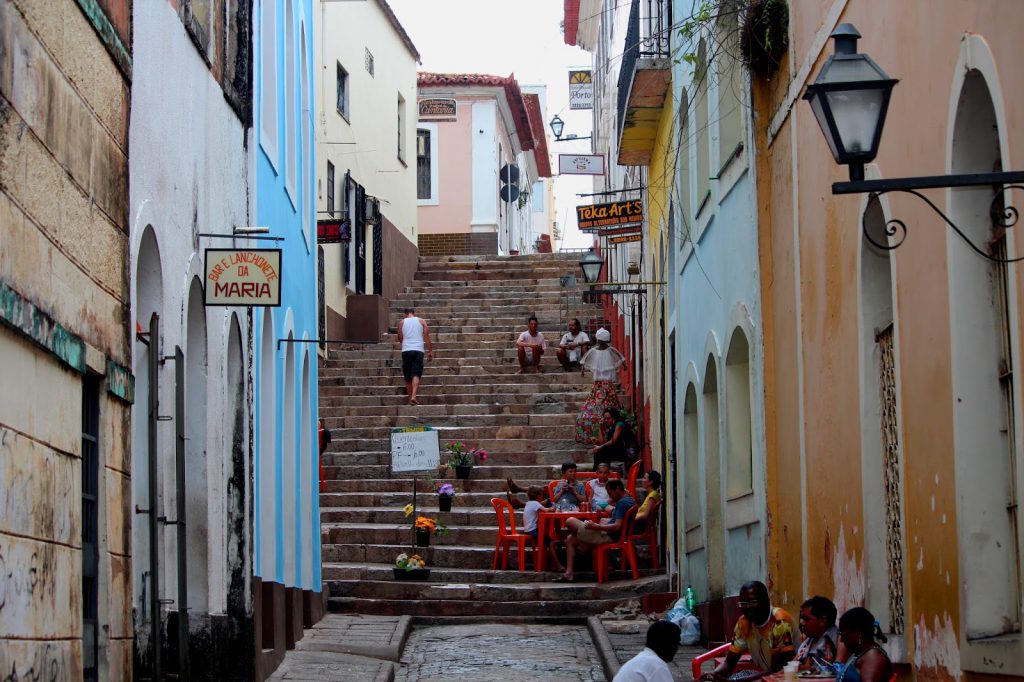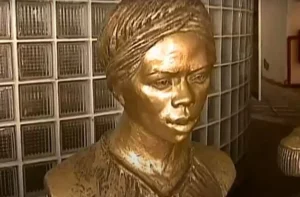Catarina Mina Street in São Luís do Maranhão
Beco Catarina Mina in São Luís do Maranhão was named in honour of the slave Catarina Rosa Pereira de Jesus, known for her great beauty. Through hard work and “favours” from the wealthy Portuguese, Catarina managed to raise enough money to buy her freedom.

History of the alley

After gaining her freedom, Catarina became rich and the mistress of many other slaves. The alley begins at Avenida Pedro II and ends at Beco da Alfândega. The alleyway is very narrow and has a staircase with 35 wide steps made of lioz stones from the 18th century.
Beco Catarina Mina (Praia Grande) is one of the few streets in the Historic Centre of São Luís named after a woman, perhaps the only one named after a black woman. In 1930 it was renamed Rua Djalma Dutra in honour of one of the heroes of the Copacabana Fort uprising of 1922.
Location and structure
The alleyway that begins at Avenida Pedro II (Largo do Palácio) and ends at Travessa da Alfândega (Rua João Gualberto) is located next to the walls of the Town Hall. Originally, the alleyway started at the Acaju beach, by the sea, corresponding to the side entrance of the palace. With a very steep slope, the alleyway later received a staircase of 35 wide steps in lioz stone, dating from the 17th century, which remains today, between the streets of Nazaré (Joaquim Távora) and Trapiche (Rua Portugal).
Commerce and Culture
There are craft shops, travel agencies, theatre groups and a few cozy bars, including the Catarina Mina Bar.
Catarina Mina’s life
Catarina Mina, or Catarina Rosa Pereira de Jesus, was one of the most beautiful black slaves in the city, who owned a stall at the foot of the slope of Calçada Street (“Canto do Tonico”), where she sold products much appreciated by the locals.
Originally from the Costa da Mina (Gulf of Guinea), where most of Brazil’s slaves came from, Catarina bought her freedom with the money she earned from her work and, as they say, from favours granted by wealthy Portuguese merchants in Praia Grande.
With her fortune, Catarina also bought the freedom of many of her friends. Once free, she became the mistress of slaves, with whom she always walked the streets of the city.
Her slaves followed her in a procession, dressed capriciously in lace and embroidery, adorned with many gold necklaces, bracelets and earrings, but barefoot according to their condition.
The mistress, like her retinue, wore fine silk and brocade, with jewellery covering her neck, ears and arms, trying to be on a par with the ladies of the time. If she had been courted by men before, without any ostentation, imagine what it was like after the “shop bath”.
Relationship with Afro-Brazilian culture
Catarina Mina‘s story is closely linked to Afro-Brazilian culture, reflecting various aspects of resistance, the struggle for freedom and the valorisation of black identity in Brazil:
- Resistance and the struggle for freedom: Catarina represents the resistance of black women who, even in adverse conditions, fought for their freedom and dignity, showing determination and ingenuity in their quest for autonomy.
- Female Empowerment: Her story highlights the role of black women in society, challenging social norms and becoming a symbol of female empowerment.
- Cultural Identity: Catarina’s story helps to preserve and promote Afro-Brazilian cultural identity, reflecting the rich contribution of Africans and their descendants to the formation of Brazilian culture.
- Social Relations and Community: Her generosity in releasing friends and her interaction with the local community demonstrate the role of solidarity and mutual support in the resilience of Afro-Brazilian culture.
- Cultural heritage: The preservation of Catarina’s memory through places like Beco Catarina Mina reaffirms the importance of Afro-Brazilian history in the construction of national identity.
- Influence on art and literature: Catarina Mina inspires artists, writers and musicians who find in her story an example of strength and overcoming, contributing to the celebration of Afro-Brazilian culture.
Conclusion
Beco Catarina Mina is not only an important tourist attraction in São Luís do Maranhão, but also an important reminder of the history and struggle of black women in Brazil. Its history reflects the resilience and contribution of Afro-Brazilian culture, enriching the national identity.
Tourist guide to São Luís do Maranhão
Publicações Relacionadas
Gonçalves Dias Square: A Historic Landmark
Church of Nossa Senhora dos Remédios History
Historical curiosities about São Luís do Maranhão
Cafua das Mercês: Preserving Black Memory Today
Palácio dos Leões: A Historical Landmark Tour
Convent and the Church of Nossa Senhora do Carmo History
Cine Éden: A Historic Cinema in São Luís
Josué Montello House of Culture in Maranhão History
Casa Real Empório: History and Culture Combined
Benedito Leite Public Library's Rich History
History and Colonial Architecture of São Luís do Maranhão
Cristo Rei Palace: Architecture of the 19th Century
This post is also on:
![]() Português
Português ![]() English
English ![]() Deutsch
Deutsch ![]() Español
Español ![]() Français
Français




















